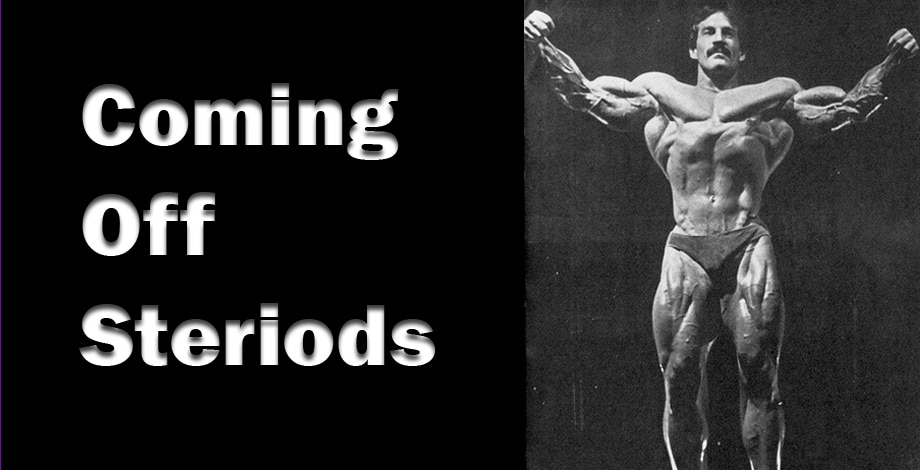ANABOLIC STEROIDS, HEALTH
How To Come Off Steroids
Last Updated on March 18, 2024 by
How to cycle off Steroids by Pat Arnold
Introduction
Heavy steroid using athletes, particularly weight lifters, bodybuilders, football players, hockey players, shotputters etc., are subject to many adverse consequences from continuous steroid use without a break and some have no idea how to come off steroids. Adverse cardiovascular effects, liver stress, HPTA downregulation, excessive virilization (women) and psychological disturbances or dependency, are some of the major problems that may develop in these individuals. Additionally, users may develop a tolerance for anabolic steroids that can only be overcome by increasing the dosage or by ceasing the use altogether. The latter, of course, is a much healthier course of action than the former.
Coming off of steroids, particularly long-term usage, is certainly not easily done without considerable loss of muscle mass. Additionally, there can be psychological effects that include depression and loss of motivation. For many athletes, especially those with schedules that do not allow prolonged periods away from competition completely coming off of steroids is not considered an option. However, if these athletes knew how to take the right approach they just might be able to cycle off and have a good chance at maintaining much of their physical condition. This could enable them to increase their ultimate potential in their sports as well as their longevity in the competitive arena.
The Strategy
The off cycle regimen must consist of proper drug, nutritional, and training protocols. The primary goals to achieve are the following:
Minimization of protein catabolism
Maintenance of muscle glycogen levels
Maintenance of high-normal red blood cell levels
Minimization of fat deposition
Avoidance of injury, or injury aggravation
Maintenance of healthy attitude and psychological state
Drugs
This is an off steroids cycle and most certainly not an off drugs cycle. In fact, the proper use of non-steroidal drugs is the mainstay of this program and is vital to its success. I will describe the drugs to be used, why they are used, and how they should be used.
Growth Hormone
GH is probably the single most important drug to maintain muscle mass and bodyweight off of steroids. While GH is not known to be great for anabolic effects, it is very effective for anti-catabolism. Anti-catabolism, or minimization of muscle mass loss, is after all what we are most interested in here. GH has an overall anti-proteolytic effect on the body and shifts the body’s metabolism away from the utilization of amino acids and glucose for energy, and towards the use of fat. The end result will be a protective effect upon muscle protein and glycogen, and a mobilizing effect upon body fat.
Many bodybuilders have discovered how wonderful GH, at the proper dosages, is in maintaining their muscle mass off of steroids. Former IFBB pro Gary Strydom once commented that he didn’t care if the IFBB tested for steroids, as long as they didn’t test for GH.
Notice how I said “at the proper dosages”. That’s right, small dosages just won’t cut it. For most people a minimum of 4 i.u. a day is required to impart a proper metabolic response in the body. Some may go as high as 18 i.u. a day but at this levels many problems can occur (i.e. edema, nerve impingement).
There probably is no great advantage to taking GH more than once a day, though some may inject twice a day. GH primarily works through its conversion to IGF-1 and the half-life of IGF-1 in the body is plenty long (8-16 hours). So once a day administration will be good enough to maintain pretty constant levels of IGF-1 in the blood. Furthermore, evidence is also mounting that GH breaks down to certain active peptide fragments with specific biological functions (i.e. lipolysis) and that these have prolonged half lives. Therefore, the active lifetime of the intact GH molecule itself in the blood might be pretty irrelevant.
GH is not cheap through most channels. However, good GH can be obtained from Asia at a fraction of the cost (10 – 20%) that it is available elsewhere.
I think I should also mention now that there is a big misconception amongst people as to what the shelf life of GH is, and that most people grossly underestimate it. The Journal of Chemical Technology states that freeze dried GH products (unreconstituted) are quite stable under refrigerated conditions, and a 24-month shelf-life is typical at this temperature. Also, although solutions of GH at neutral pH readily deamidate (lose ammonia group from end of molecule), and storage of the reconstituted product is limited to a few weeks under refrigerated conditions, biological activity is relatively unaffected even after prolonged storage. So the stuff really stays pretty active in the ‘frig for a considerable time. By the way, reconstituted solutions of GH should NEVER be frozen (this will be the death of it).
Lis-Pro Insulin (Humalog®)
The use of insulin provides a couple of very important functions in the off steroid period. First of all, it helps preserve glycogen storage in the muscle. Steroids are very good at stimulating glycogen storage and this property likely plays an integral part in their performance enhancing benefits. Going off of steroids leads to a reversal of this and the result is muscular weakness, fatigue, and loss of size and bodyweight. The proper use of insulin can help minimize this.
Furthermore, insulin can help to minimize protein breakdown through its anti-proteolytic effects. Insulin is quite potent in regards to its protective effect on muscle protein, unfortunately it also is very potent in regards to its protective effect on maintaining body fat. Insulin therefore has to be used in the proper fashion to maximize the former, and minimize the latter.
The proper usage of insulin requires the fast acting insulin analog known as Lis-Pro insulin, or Humalog®. This altered insulin product is available only by prescription. It differs from other insulin in that it is absorbed quickly into the body after subcutaneous injection. The average time to peak blood levels is 90 minutes and generally it is out of your system in 3 to 4 hours.
Humalog® is to be taken immediately after training. The physiology of the body after intense training is such that the benefits of insulin can be maximized, while drawbacks are minimized. Muscle insulin sensitivity as well as insulin independent glucose uptake will peak in the 2-3 hours or so after training. In this time, insulin will preferentially stimulate glucose uptake and glycogen synthesis in muscle over fat. Additionally, high insulin levels at this time will help to counteract the catabolic state that exists in muscles right after they have been damaged by training. A discernible improvement in training recovery (less soreness and injury pain) is often noticed by individuals who utilize this technique.
Humalog® administration must be followed by intake of simple carbohydrates and protein within 20 minutes. A general rule is one unit of Humalog® per ten kilograms bodyweight, and ten grams of carbs and ten grams of protein per unit of Humalog®. That sounds like a lot of carbs and protein but it must be ingested. Whey protein is best, and glucose or maltodextrin can be used for the carbs. 5 grams of creatine can also be added as well as well as 5-10 grams of glutamine.
Erythropoietin (EPO)
Erythropoietin (EPO) is a protein hormone secreted by the kidneys and liver that stimulates red blood cell production (erythropoiesis). Red blood cells carry oxygen to the tissues of the body and so obviously are vital to maximal health and athletic performance.
When people take anabolic steroids, particularly some oral ones such as Anadrol®, erythropoiesis is stimulated. The result is an increase in the proportion of blood cells in the blood, also known as the hematocrit. This increase in the hematocrit is partially responsible for the energizing and recovery benefits of steroids. It may also contribute to the blood volume and vascularizing effects of anabolics.
When you go off anabolics, the increase in hematocrit gradually subsides and you return to pre-cycle lower levels (or below). This effect will take its toll on your physical condition and ability to train at high intensity. Therefore, administration of exogenous EPO can have obvious benefits in the steroid withdrawing athlete.
In addition to its effect in increasing hematocrit, there is some evidence that EPO has direct anabolic effects. It has been shown in rat studies to substantially increase weight gain and injury repair after surgery. Furthermore, EPO receptors are present on myoblasts (immature muscle cell progenitors) and may have a potential in muscle development and repair.
EPO is sold in recombinant form (rhEPO) for injection. One popular form is called Epogen®, and it is made for subcutaneous usage. A safe or starting dosage is usually 20 i.u. per kilogram bodyweight, 3 times/week. After two or three weeks, a maintanence dose of 20 iu/kg BW can be taken once a week. One should wait about two weeks after ceasing steroids to commence EPO therapy to avoid any excessive increases in hematocrit which can be quite dangerous. It is also very advisable to have periodic blood tests that include a hematocrit assay while taking EPO just to be safe. Interestingly, I think that this test is automatically done for free everytime you donate blood, and all you need to do is ask the nurse what your hematocrit is reading (just out of curiosity of course).
COUPON CODE: T20
COUPON CODE: ANABOLIC







